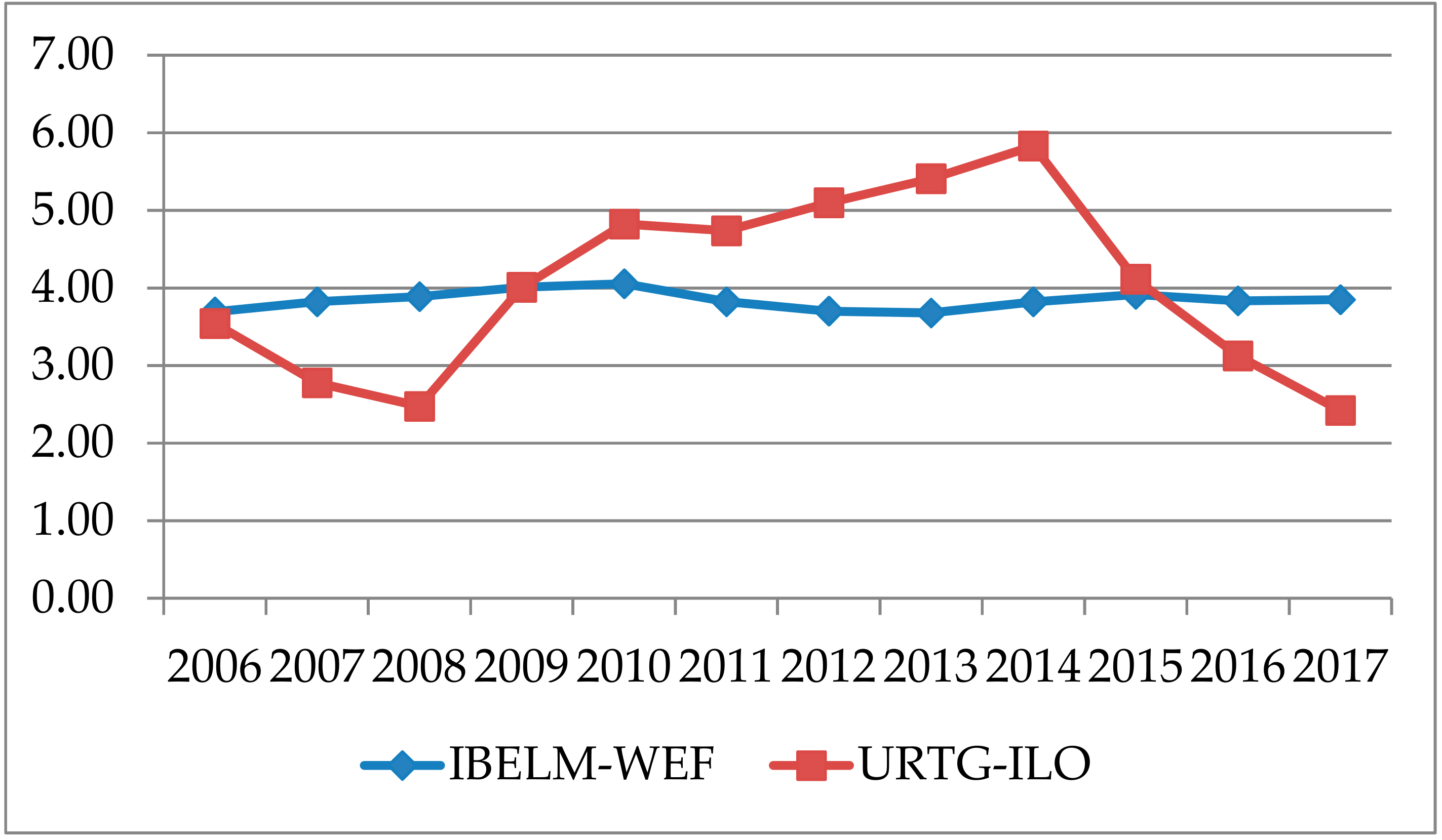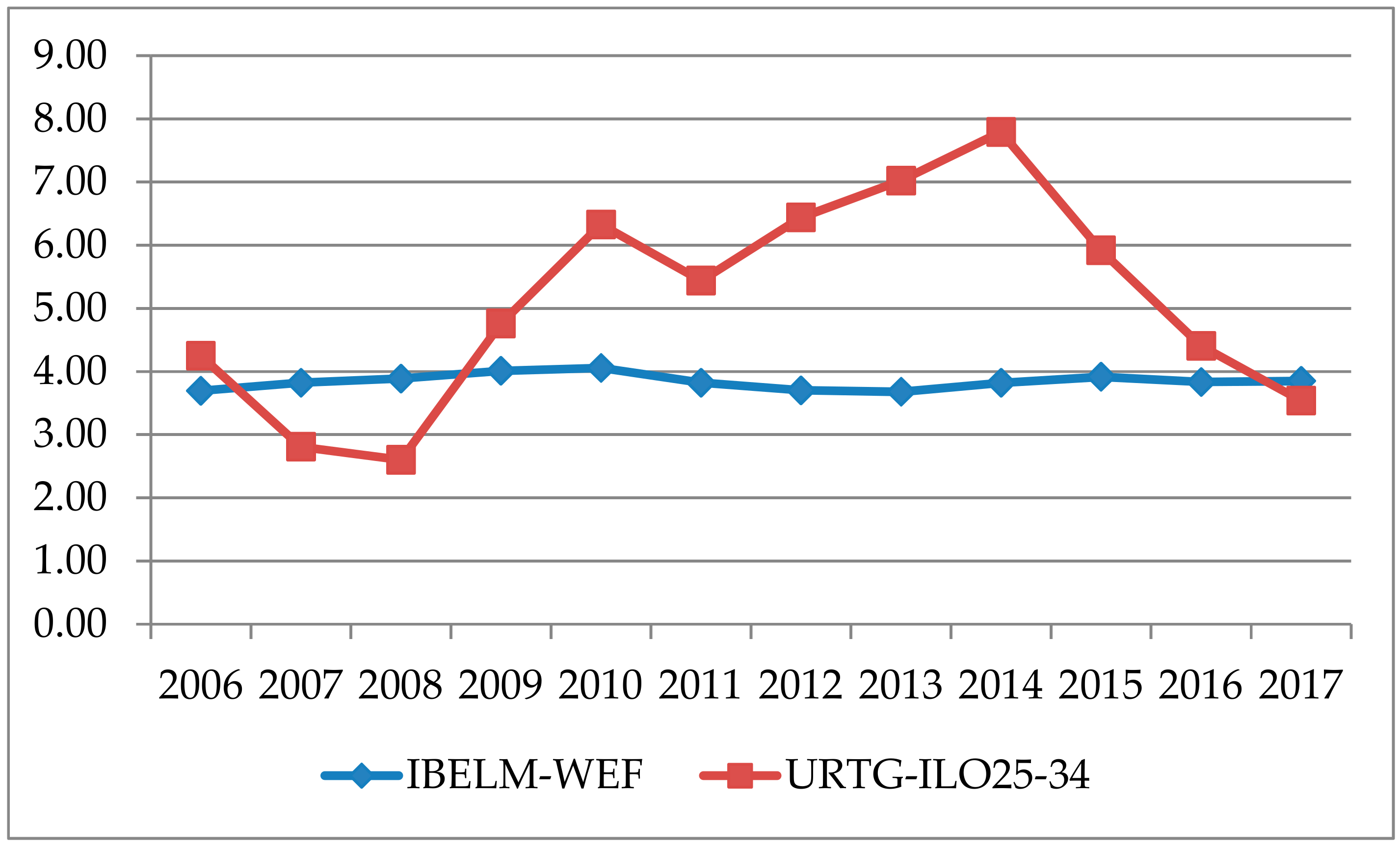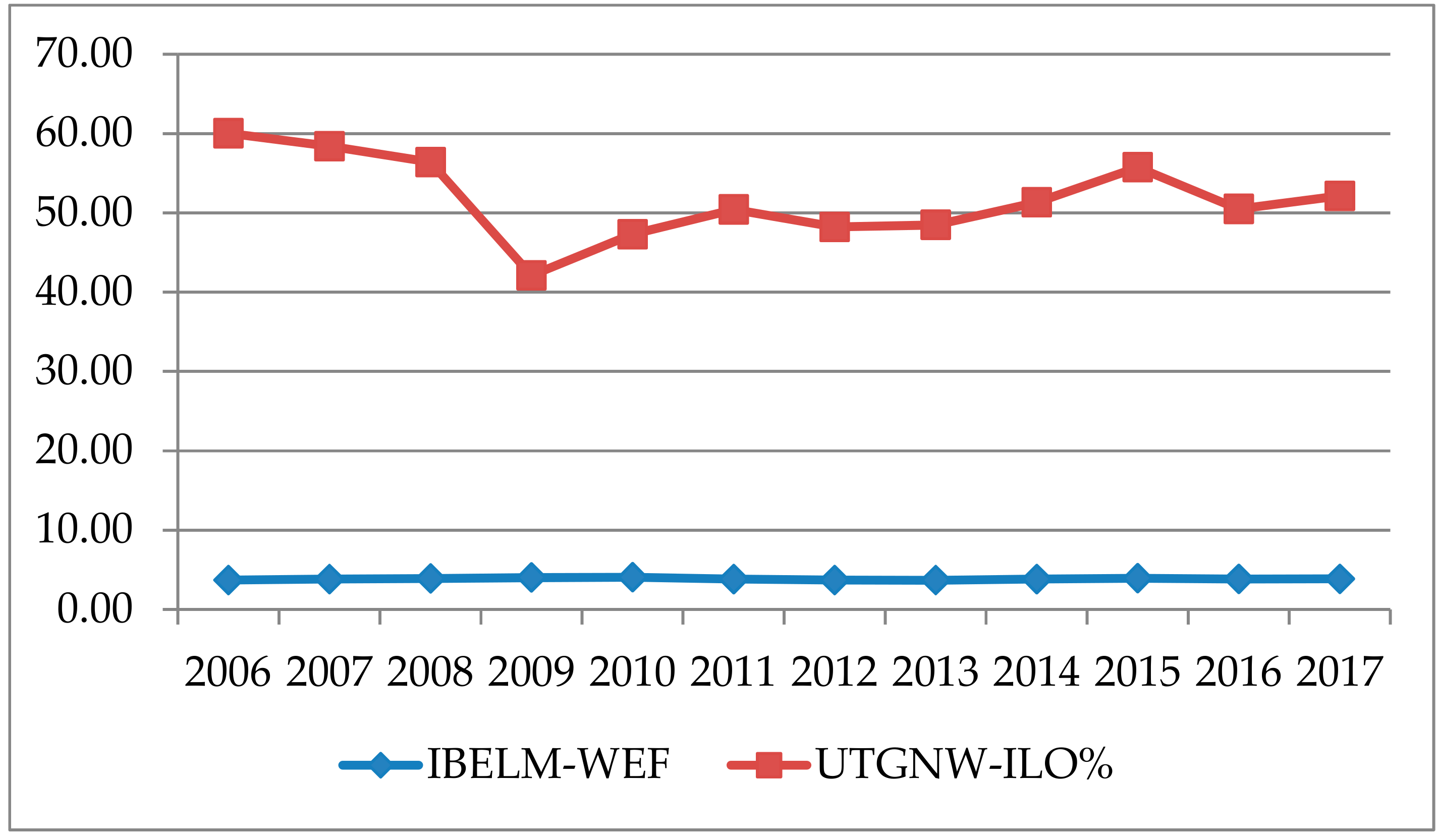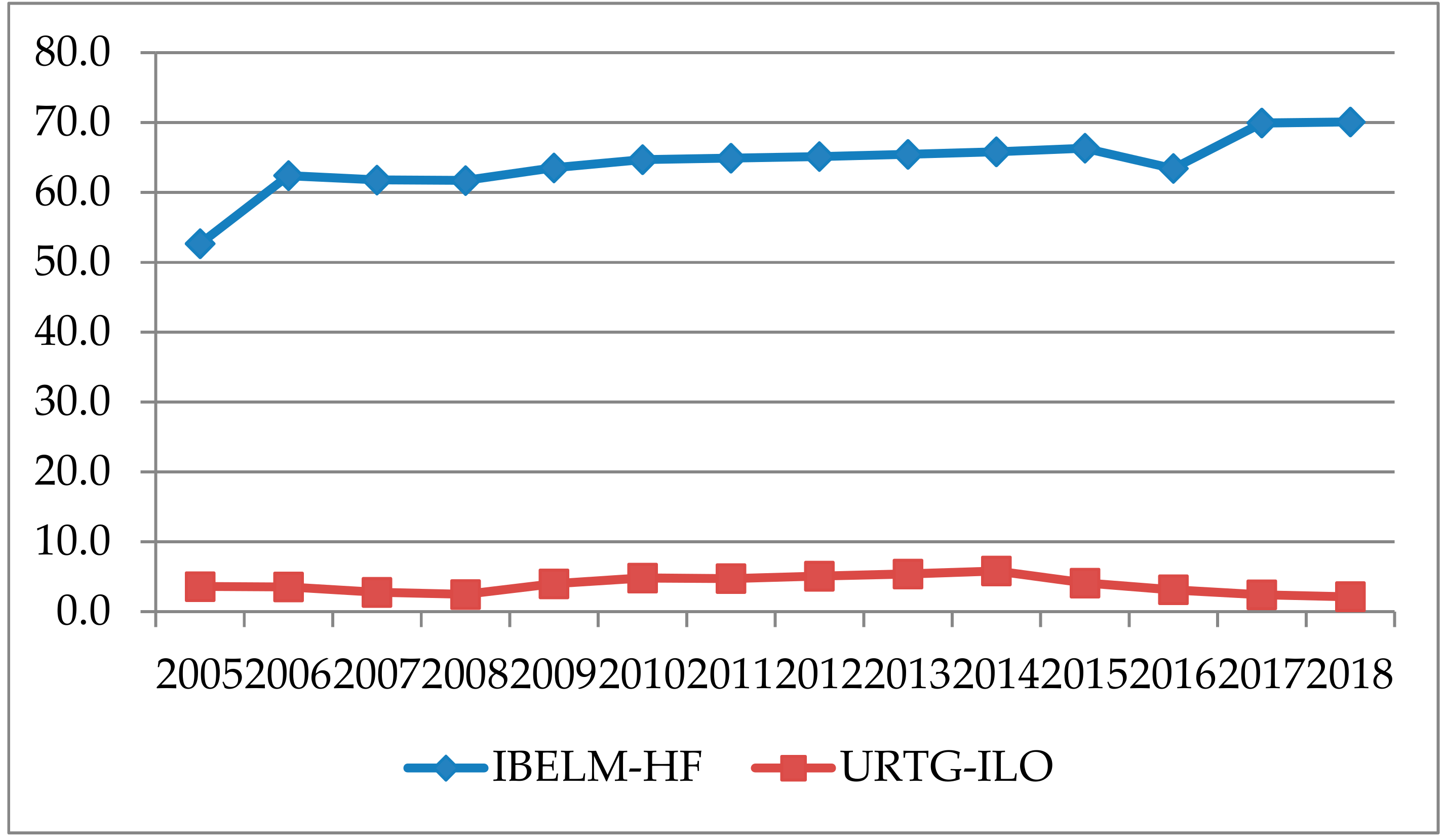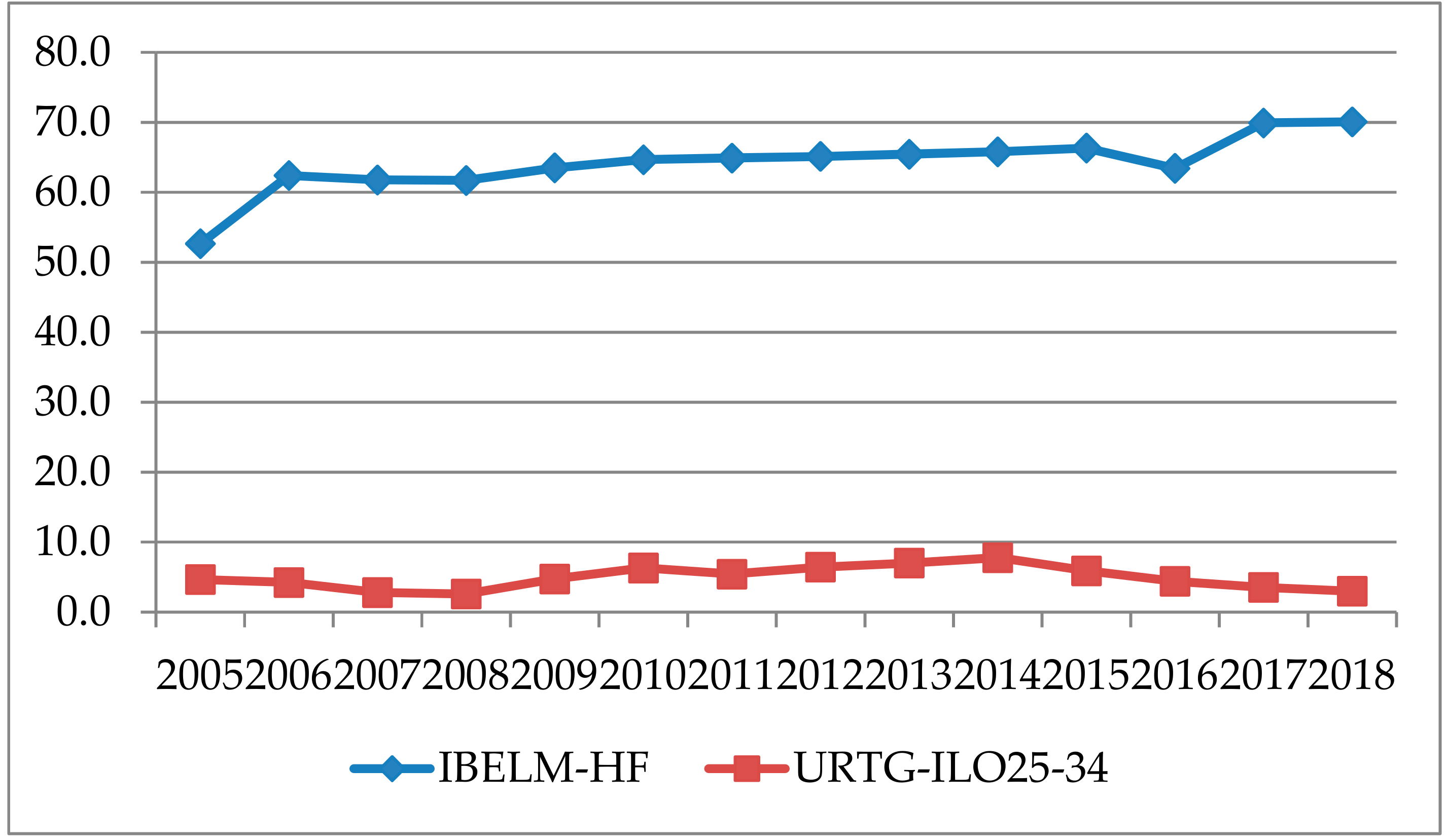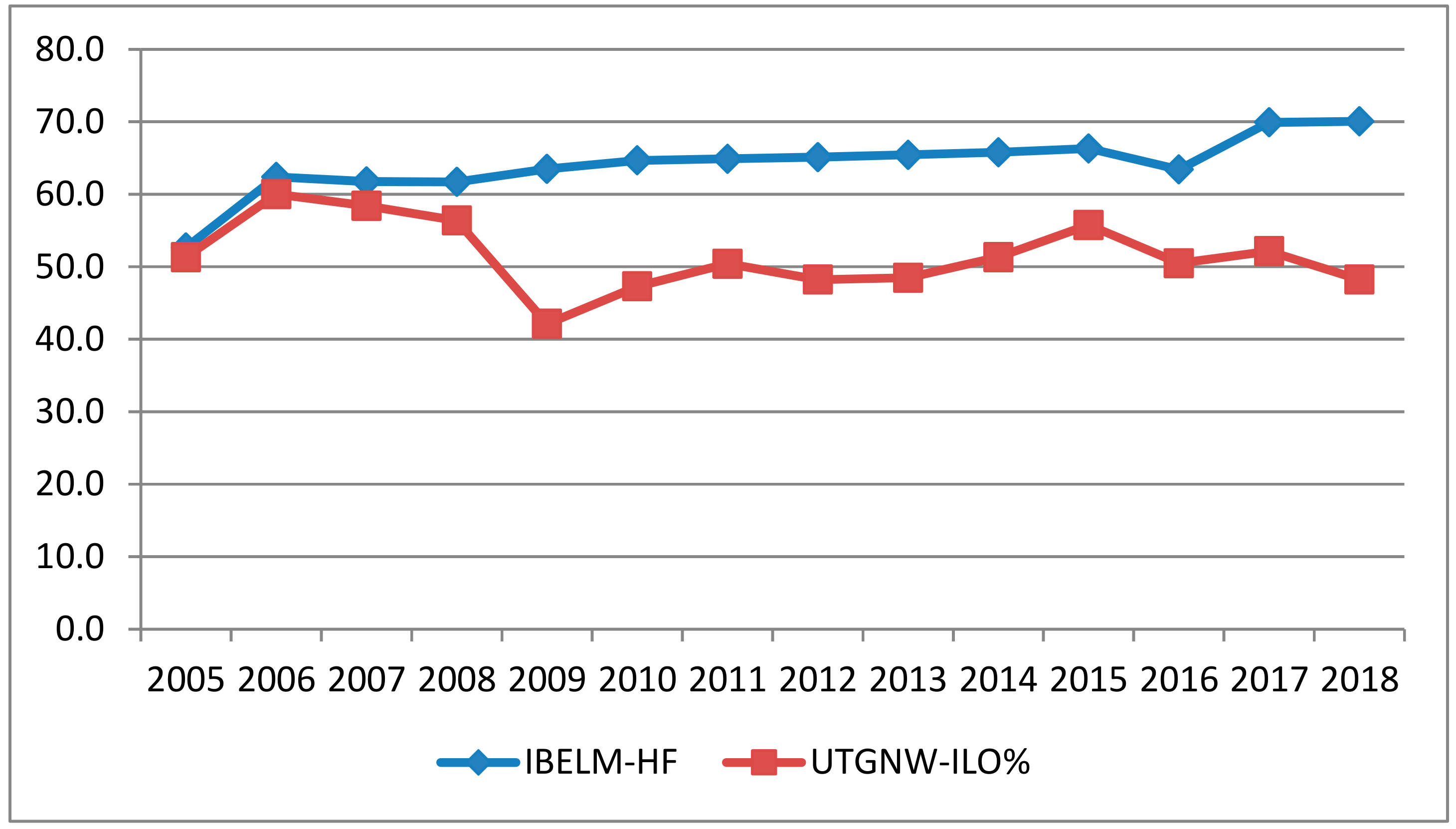1. Introduction
The process of economic growth in the European Union (EU) is structured within and as goal of input–output strategies (I-OS), which are mainly quantitative. The Europe 2020 Strategy is designed based on the I-OS model. At the very heart of this strategy—that is influenced by the human capital theory—lies education as a key factor for the economic growth and quality improvement of the labour force [
1,
2,
3,
4,
5]. Education, as part of the European agenda, is credited with the capacity to render economies more competitive within the endeavour of achieving sustainable growth. Two out of the seven flagships proposed by the Commission explain the connection between sustainable growth, education and the labour market: Youth on the move—“to enhance the performance of education systems and to facilitate the entry of young people to the labour market”, and an agenda for new skills and jobs—“to modernise labour markets and empower people by developing their skills throughout the lifecycle with a view to increase labour participation and better match labour supply and demand, including through labour mobility” [
6].
Higher educational attainment is also a priority of the agenda of OECD countries as it is credited with the capability of enhancing individual and collective well-being [
7]. According to Sustainable Development Goal 4, one of the targets to be reached by the year 2030 is to ensure universal access to affordable and quality technical, vocational, and tertiary education, including university [
8].
Higher education is seen as the main creator and originator of education, research, and technology and plays a crucial role in social change and development, which are, in turn, essential for achieving sustainable development [
9,
10,
11,
12]. It is considered that following an increase in inputs (more subsidies for higher education), the levels of higher education attainment will also increase, which will lead to positive results (outputs) translated into higher productivity, innovation, and competitiveness in the economy, from a macroeconomic perspective, as well as to wage returns of extra years of education from a microeconomic perspective [
13,
14,
15]. Existing research indicates that people with higher education are less likely to be overeducated and to undergo a shorter length of unemployment [
16].
However, I-OS tends to cast aside a consequence that may occur as a result of subsidising higher education—overeducation. Overeducation is the situation in which individuals, having attained a certain higher educational level required by the pursued job, eventually earn lower incomes than those expected and requested according to and justified by their educational attainment. Educational expansion generated by educational systems is the main source of overeducation, with the role of the labour market being neglected [
17]. The concept was popularised by the influential work authored by Freeman [
18]. It was further developed in the following decades due to the concern of economists in explaining the impact of financing education on the labour market.
Overeducation is brought about during integration into the labour market [
19] due to job mismatches, which are assessed by comparing educational attainment and job-required education [
20] and heterogeneous workers [
21]. Overeducation can stem from a horizontal mismatch—i.e., working in a job not related to the field of study or from skill mismatch—i.e., working in a job that requires lower skills than acquired [
22]. The determinant of overeducation is the voluntary decision of the individual to acquire more qualifications than those required at work. Therefore, overeducation is argued to have a signalling role, allowing workers to compensate for the lack of other skills or to gain access to the labour market [
23].
In the case of education–occupation match, higher levels of education increase an individual’s earnings [
24]. However, research shows that the overeducated earn less than their peers in graduate jobs. In other words, the return on surplus education is less than the return on required education [
25,
26], one of the reasons being that overeducation may originate from the lack of skills of graduates [
27]. In fact, recruitment is rather based on initial training during studies than on the educational attainment level [
28]. Overqualification generates a wage premium relative to the job, but a penalty relative to the qualification [
29,
30]. Overeducation is tested and confirmed when education levels rise in jobs that offer very low returns to education and undergoing little technological change [
31].
Studies distinguish between real and formal overeducation, according to whether or not it is accompanied by underutilisation of skills. While it was found that in Britain, real overeducation implies higher pay penalties and more acute job dissatisfaction, [
32] research from the German labour market contradicts previous empirical findings—no significant difference was identified with respect to job satisfaction between overeducated employees and their correctly allocated peers [
33]. Overeducation, skills/knowledge underutilisation, and mismatch in the field of education are all similar negative phenomena that ultimately lead to underemployment [
34].
The labour force growth rate has been found to have a positive effect on the incidence of overeducation, while the unemployment rate has a negative effect on the rate of return to education [
35]. In this age of mass higher education participation, graduate underemployment or unemployment is an indicator of macroeconomic disequilibrium in the graduate labour market. This calls for a reconsideration of the purposes of higher education [
36].
It has been demonstrated that overeducation may be a persistent phenomenon in post-communist countries, as in the case of Poland. More precisely, being in a job with lower educational requirements than the educational attainment level is likely to persist for at least five years. At the same time, the incidence of overeducation increases more rapidly during times of economic downturn, with the youngest cohorts aged 26–35 facing the highest risk of persistent overqualification [
37].
Although it is a highly important concept in the context of European strategies, overeducation has several limits that kerb its significance. Being a phenomenon stemming mainly from the mismatch between skills acquired through education and skills required for a job, overeducation is strictly limited to the relationship between higher education and the labour market. Moreover, an exaggerated focus is set on the quantitative aspects describing the phenomenon, with increasing concerns related to measurement errors [
38]. Seen as such, the concept loses sight of the phenomena taking place in the educational environment, which are inseparable from the institutional implications triggered by I-OS. The latter derive from debatable assumptions according to which there is an excess of highly qualified labour demand and that companies will improve their production techniques to integrate highly qualified labour force [
39].
By reason of these observations, it is necessary to extend the significance of overeducation as a concept. This extension should refer to the inclusion of the implied institutional arrangements of the business environment and labour market. This is the reason why we distinguish between qualitative overeducation (QLOE) and quantitative overeducation (QTOE) [
40].
With regard to this taxonomy, QLOE appears as a consequence of mismatches existing on the labour market between the skills acquired through the education process and the skills required by the existing jobs. The subjects of education realise that they have acquired skills superior to those required. The extension of this phenomenon tends to reduce the actually earned wages below the anticipated ones. This consequence is due to overeducation, according to the broadly accepted theory. In terms of consequences of overeducation, its harmfulness depends on the quality of institutional arrangements describing labour market transactions. Thus, on a labour market affected by institutional rigidities, with high transaction costs, QLOE is prone to appear and/or to persist.
QTOE is described by an exaggeratedly large number of graduates on different levels of higher education or by a large number of graduates who only wish to get hold of as many diplomas and graduation certificates as possible, which would further allow them to be better placed in the labour market. We argue that QTOE is a consequence of I-OS-generated incentives. Its harmfulness is more acute than that of QLOE because it does not only refer to a mere mismatch of skills in the labour market but it additionally generates an excessive number of highly educated graduates.
QLOE is expressed by the mismatch between anticipated returns on education and the actual earnings in the job due to acquired skills superior to the ones required. As QLOE depends on each individual’s prior assessment and expectations compared to the actual context in the labour market, it cannot be numerically quantified or aggregated for the entire number of graduates. On the other hand, QTOE is a quantitative measure of overeducation because it only accounts for the number of graduates being in this situation, i.e., the number of tertiary graduates holding diplomas certifying a level of education superior to the one required.
Moreover, as a result of subsidising higher education, individuals enrolled in higher education programmes may not necessarily aim at acquiring skills or specific certificates, but they may also be willing to profit from the incentives provided by the educational system in order to postpone their labour market entry or, on the contrary, to postpone unemployment. This type of behaviour may be encouraged by institutional arrangements governing the operation of unreformed public educational systems, within which educational organisations are sensitive to changes in budget constraints and they do not depend on the transformations in the business environment or the labour market [
41].
Considering all of the above, the following hypothesis is outlined: I-OS, which are based on massive subsidies for education and on pursuing quantitative targets, are likely to lead to overeducation, or, even more severely, to QTOE. The impact of overeducation depends on the quality of institutional arrangements of business environment and labour market (IBELM). The purpose of this paper is to highlight how IBELM specifically influences QTOE.
This hypothesis is based on the neoinstitutional economics literature according to which formal and informal rules in the economy influence the participants’ behaviour in transactions in various markets [
42,
43,
44,
45], affect quality of entrepreneurship [
46,
47,
48,
49], and even an economy’s overall performance [
50,
51,
52,
53,
54]. Under these conditions, it is expected that a business environment in which the institutional context supports initiatives, creativity, investment increases, and, implicitly, diversification of transactions on the labour market can contribute to the decrease in overeducation levels.
2. Materials and Methods
In order to highlight the influence of quality of institutional arrangements of business environment and labour market (IBELM) on QTOE, a qualitative analysis was performed. The qualitative analysis consisted in collecting and interpreting the relevant data for describing institutional arrangements in the business environment and the labour market. Using codification, the data were converted into specific indicators, which were then used to check the validity of the formulated hypothesis. The qualitative analysis is aimed at highlighting the following hypothesis: Institutional arrangements encouraging the development of the business environment through new initiatives and/or the development of already existing initiatives could lead to a decrease in QTOE. This is because tertiary graduates could find jobs more easily. By contrast, an unbeneficial institutional environment in which business initiatives are discouraged would tend to contribute to the proliferation of QTOE. Therefore, the existence of a negative relationship between the institutional quality of business environment and labour market, on one hand, and QTOE, on the other hand, is expected to be confirmed through the qualitative analysis. The interpretation of results is performed from the perspective of the prescriptions of neoinstitutional economics theories.
IBELM was expressed using two indicators that were designed based on the data provided by the Global Competitiveness Report of the World Economic Forum (IBELM-WEF) and by the Index of Economic Freedom Report of the Heritage Foundation (IBELM-HF). For the purpose of our research, in the mentioned reports, we identified and used data pertaining to those areas that measure IBELM. The analysis is focused on the Romanian data available for the period 2006–2017 in the case of IBELM-WEF, and for the period 2005–2018 in the case of IBELM-HF, respectively.
Three indicators are used to express QTOE: 1) The rate of unemployment among tertiary graduates, using the International Labour Organisation (ILO) methodology (URTG-ILO); 2) The rate of unemployment among tertiary graduates for the graduates aged 25–34 (URTG-ILO25–34). This age category was chosen because the persons included herein are recent graduates with presumably little or no experience. Therefore, these persons face a higher risk of not finding a job or of losing their job; 3) The rate of the unemployed who never worked among tertiary graduates, calculated according to the ILO methodology (UTGNW-ILO%). This indicator is relevant to measure QTOE because it reflects the extent to which skills acquired through higher education are not used on the labour market.
The qualitative analysis consists in comparing the evolutions of IBELM-WEF and IBELM-HF, considered separately, with URTG-ILO, URTG-ILO25–34, UTGNW-ILO% for the period 2006–2017, and 2005–2018, respectively.
Below are presented the methodological aspects regarding the design and calculation of the abovementioned indicators.
2.1. The Indicator of Institutional Quality of Business Environment and Labour Market—World Economic Forum (IBELM-WEF)
In designing IBELM-WEF, we used the data provided by the Global Competitiveness Report calculated by the World Economic Forum. The analysed reports present data for the period 2006–2017, which are used for calculating the Global Competitiveness Index (GCI). GCI is calculated based on scores from 1 to 7 for 12 pillars: Institutions, infrastructure, macroeconomic environment, health and primary education, higher education and training, goods market efficiency, labour market efficiency, financial market development, technological readiness, market size, business sophistication, and innovation [
55]. The choice of the time range under scrutiny is dictated by the methodological compatibilities accompanying the GCI calculation. Starting from 2018, the GCI methodology changed, which made it inadequate to compare the scores before 2018 with the scores thereafter [
56].
For the purposes of this research, from this indicator, we only selected the components referring to institutional arrangements of business environment and labour market. More specifically, data pertaining to two of the GCI pillars were included: Institutions and labour market efficiency. It is useful to make a few remarks about the manner in which the indicator was designed. The 12 pillars of the GCI are grouped into three larger categories describing the coordinates of an economy’s competitiveness. These categories refer to a competitive economy’s basic structural and qualitative elements (basic requirements), elements contributing to the increase of an economy’s efficiency within the competitiveness process (efficiency enhancers), and factors describing an economy’s innovation and sophistication degree (innovation and sophistication factors). Each of the three categories has a variable weight within GCI. For Romania, the weights are 40% for basic requirements, 50% for efficiency enhancers and 10% for innovation and sophistication factors, respectively, for the period 2006–2016 [
57]. For the year 2017, the corresponding weights for the three categories were 38.8%, 50%, and 11.2%, respectively [
55].
The pillars used for designing IBELM-WEF, i.e., institutions and labour market efficiency, are contained in the first two categories. More precisely, institutions falls under the basic requirements category, and labour market efficiency is an efficiency enhancer. The institutions pillar has two components: Public institutions and private institutions. The first component refers to formal rules, regulations regarding property rights, and aspects deriving from government intervention in the economy, e.g., irregular payments and bribes and diversion of public funds. The second component focuses on the business environment, mainly on internal institutional aspects, unlike the previous one, which reflects the influence of the external institutional framework on the business environment. Within the institutions pillar, the two components have the following weights: 75% (public institutions) and 25% (private institutions), respectively. The labour market efficiency pillar has two components: Flexibility and efficient use of talent. Both are relevant for the institutional quality of business environment and labour market. The first component includes flexibility of wage determination, hiring and firing practices, and the effect of taxation on incentives to work. The second component refers to payment and productivity, reliance on professional management, and country capacity to retain/attract talent. Each of the two components has a weight of 50% within the pillar [
55].
The scores for each pillar, institutions and labour market efficiency respectively, were calculated using weighted averages. As these pillars belong to different categories within GCI, new weights had to be recalculated in order to determine IBELM-WEF, in line with the GCI methodology. Given that the IBELM-WEF components described above represent only two out of the three categories of GCI and because they have different weights as per GCI methodology, new specific weights were calculated. Within the recalculation, the weight of the third category (innovation and sophistication factors) was shared between the two categories found in the new indicator (basic requirements and efficiency enhancers). The new weights were calculated differently for the period 2006–2016 and for the year 2017, respectively, because the weights for the three categories are different for the two time ranges, as mentioned above.
Thus, for the institutions pillar, the new weight for the period 2006–2016 was calculated as follows:
where 40% is the weight assigned according to the CGI methodology; 10% × 40/90 is the additional weight obtained after sharing the third category.
For the year 2017, the new weight is:
where 38.8% is the weight assigned according to the CGI methodology; 11.2% × 38.8/88.8 is the additional weight obtained after sharing the third category.
The weight for the labour market efficiency pillar for the period 2006–2016 was determined as follows:
where 50% is the weight assigned according to the CGI methodology; 10% × 50/90 is the additional weight obtained after sharing the third category.
where 50% is the weight assigned according to the CGI methodology; 11.2% × 50/88.8 is the additional weight obtained after sharing the third category.
IBELM-WEF describes the institutional quality of business environment and labour market for the time range 2006–2017. The way it was conceived, each indicator it includes measures the quality of the concerned component using a scale from 1 to 7 best (
Table 1).
A fluctuating evolution can be noticed for the values of IBELM-WEF, which is also true for each of its components. The lowest scores are those of public institutions, i.e. for the institutional cues most critical for business environment and labour market. These values suggest a burdensome institutional framework for the business environment, which is accompanied by high transaction costs. These costs then reflect upon the labour market relations. After a steady increase in the period 2006–2010, it then started to decrease for three years in a row. Starting from 2014, it had again an increasing trend. Private institutions had a similar evolution, with a more fluctuating evolution after the crisis. The values of 2006 and 2017 are the same, which means that private institutions did not manage to entirely recover after the crisis, but only to reach the same level. This means that the business environment did not benefit from sufficiently developed institutional arrangements to enhance its adaptability during crisis. It can be noticed that there is compatibility between institutions and labour market efficiency sub-indicators. The poor institutional quality of the business environment is negatively reflected mostly upon efficient use of talent, which means firms cannot fully use the skills created via formal higher education. The low values of this sub-indicator could be explained by the lack of skills of higher education graduates. Decreasing scores during 2010–2017 (and not only during the crisis) suggest that this is an issue firms are faced with constantly, not just a contextual one. This could be an indicator of QTOE—graduates’ skills are formally certified, but they are not adequate for the labour market or graduates are not able to use them at work. Additionally, the low values of this sub-indicator could also explain the low values of private institutions—if firms cannot efficiently use the employees’ talent, then they are neither able to develop internal institutional solutions to render them more market-adaptable, especially under crisis conditions. The flexibility component had a very fluctuating evolution until 2013, when it eventually took on an increasing trend.
2.2. The Indicator of Institutional Quality of Business environment and Labour Market—Heritage Foundation (IBELM-HF)
The indicator IBELM-HF was designed based on the data provided by the Heritage Foundation within the Index of Economic Freedom (IEF). The Index of Economic Freedom (IEF) is calculated based on 12 components describing four pillars of economic freedom: Rule of law (property rights, judicial effectiveness, and government integrity), government size (tax burden, government spending, and fiscal health), regulatory efficiency (business freedom, labour freedom, and monetary freedom), and market openness (trade freedom, investment freedom, and financial freedom) [
58]. The scores of each component are graded on a scale from 0 to 100 and are equally weighted and averaged.
For the purpose of this paper, 4 of the 12 components were considered to describe IBELM-HF: Property rights (PR), tax burden (TB), business freedom (BF), and labour freedom (LF). The choice lies in the following hypothesis: A higher degree of freedom for the business environment and labour market relations contributes to reducing the effects of overeducation. This hypothesis is valid both with reference to quantitative overeducation (the number of unemployed tertiary graduates falls) and with reference to qualitative overeducation (a flexible labour market increases the chances for diversified and better paid jobs to appear, thus reducing the negative implications of overeducation). In order to preserve data accuracy and the original calculation methodology, IBELM-HF is calculated in the same manner as IEF: The average score of the components, which have equal weights.
Starting with the 2017 Index of Economic Freedom, Heritage Foundation made some methodological changes in calculating IEF [
58]. Previously, IEF was using only 10 components to measure economic freedom. The component property rights (PR) was measured based on scores assessed from 0 to 100 according to a series of criteria reflecting the degree to which a country’s laws protect private property rights, the likelihood that private property will be expropriated by the state, the existence of corruption within the judiciary, and the ability of individuals and businesses to enforce contracts. [
58]. Starting with 2017, the score for PR component of IEF is derived by averaging scores for five subfactors, all of which being weighted equally: Physical property rights, intellectual property rights, strength of investor protection, risk of expropriation and quality of land administration.
Tax Burden (TB), a component of Government size area since the 2017 Report, is identified as fiscal freedom (FF) in the previous reports.
IBELM-HF measures the institutional quality of business environment and labour market on a scale from 0 to 100 (best) (
Table 2).
Analysing the results for the four areas, it can be noticed that Romania has relatively low scores for property rights and labour freedom for the majority of years under examination. For the first component, the scores indicate a low level of respect for property rights and low efficiency of the legal system. Also, the component is an indicator of corruption and of the possibility that the legal system is influenced by other governmental organisations. Despite this, property rights experienced the highest increase during 2005–2018. Although the second component follows an ascending trend after 2008, progress is meagre and basically describes low scores (out of 100). Therefore, the quality of the labour market is weak, being characterised by institutional rigidities. The other two components have relatively high values, with fluctuations on an upward trend for tax burden or following a decreasing trend after the crisis onset for business freedom. IBELM-HF steadily improves after the economic crisis. The best performance in terms of institutional quality of business environment and labour market was recorded in 2008.
Compared with IBELM-WEF, IBELM-HF has been increasing, but still has relatively low scores. This shows an improvement of the institutional quality of business environment and labour market for the entire analysed time frame in a clearer way than the one highlighted by IBELM-WEF. However, proportionally, the scores of IBELM-HF are not substantially higher than those of IBELM-WEF. The larger amplitude could be explained by the differences in weight allocation of each component within the two indicators.
2.3. The Unemployment Rate among Tertiary Graduates, ILO Methodology (URTG-ILO) and the Unemployment Rate among Tertiary Graduates, ILO Methodology, Age 25–34 (URTG-ILO25–34)
URTG-ILO was calculated based on the data provided by the Romanian National Institute of Statistics, the Household Labour Force Survey, (AMIGO) regarding unemployment among tertiary graduates, using ILO methodology (UTG-ILO) [
59] and the data regarding employment among tertiary graduates (ETG) [
59]. URTG-ILO was calculated as percentage ratio between UTG-ILO, on one hand, and the sum of UTG-ILO and ETG, on the other hand. The same data base and the same calculation were used for URTG-ILO25–34 [
59].
2.4. The Rate of the Unemployed Who Never Worked among Tertiary Graduates, ILO Methodology (UTGNW-ILO%)
UTGNW-ILO% was determined as a percentage ratio between the number of unemployed tertiary graduates who never worked (UTGNW-ILO) and the total number of unemployed tertiary graduates (UTG-ILO). The data were provided by the Romanian National Institute of Statistics, the Household Labour Force Survey, (AMIGO) [
59].
4. Discussion and Conclusions
The research underlines the implications of input–output strategies for the business environment and labour market in Romania. Overeducation is an inevitable effect of these strategies, which tends to exacerbate under conditions of unfavourable institutional arrangements for the business environment and labour market relations. The most pernicious phenomenon is quantitative overeducation, which manifests itself through the increase in the number of graduates in the educational environment and the increase in the number of unemployed on the labour market. It also hampers the process of achieving the goals of sustainable development through higher education. Quantitative overeducation may arise due to contradictions between I-OS objectives and sustainable growth strategies.
As an alternative, qualified tertiary graduates may be willing to offer their skills and competencies to business environments that afford a better pay for them and, implicitly, a better return on educational expenses. This is the reason why qualitative overeducation is just a transitory phenomenon and without a significant influence on the overeducated. Dysfunctionalities in the business environment and labour market, i.e., institutional rigidities that hamper the diversification of business and the advent of additional opportunities to use the higher educated labour force, tend to generate quantitative overeducation. Excess higher educated labour supply can increase the risk of overeducation, especially given the existing institutional rigidities.
The research conducted highlights a negative but weak correlation between the designed indicators and the rate of tertiary graduates who never worked among unemployed tertiary graduates. This shows that in the absence of an institutional framework meant to stimulate business opportunities and to support flexibility in the labour market, tertiary graduates face the risk of not being able to use the acquired skills. This is the most obvious and harmful form of quantitative overeducation. The intensity of this phenomenon is even higher during economic crises and is fuelled by I-OS.
An inverse relationship has been identified between IBELM-WEF and URTG-ILO as well as URTG-ILO25–34 and UTGNW-ILO%. The strongest correlation was found between IBELM-WEF and UTGNW-ILO%. This is even more obvious taking into consideration that before the crisis onset, the number of tertiary graduates reached very high levels. Despite this, UTG-ILO decreases, including UTGNW-ILO.
As for the second indicator, no significant correlation was found between IBELM-HF and URTG-ILO, nor between IBELM-HF and URTG-ILO25–34. A weak negative correlation was found to be between IBELM-HF and UTGNW-ILO%. The main conclusion of the research is that the better the quality of the institutional arrangements for business environment and labour market, the lower URTG-ILO, and URTG-ILO25–34.
The main research limitation is the time frame for which data are available for calculating IBELM-WEF, as the World Economic Forum has been calculated GCI since 2006. Heritage Foundation has reported data for labour flexibility since 2005, which reduces the time frame for calculating IBELM-HF. The changes in the GCI calculation methodology have also limited the time frame for the analysis and calculation of IBELM-WEF. Another limitation was the availability of data required to calculate UTGNW-ILO%. The Romanian National Institute of Statistics reports aggregated data on UTGNW-ILO, and not by age. This limitation was an impediment, as it did not allow for a more applied analysis of overeducation, namely, to explicitly include the number of tertiary graduates who never worked, aged 25–34. Also, the limitation was extended by the impossibility to make a clear comparison between UTGNW-ILO% and URTG-ILO25–34. Data on tertiary graduates are reported for tertiary education bachelor studies for the period 2006–2013, while data on master, doctoral, and postdoctoral are unavailable for this time frame. These categories are reported starting with 2014. For this reason, the analysis focuses on the number of bachelor graduates for the entire time frame analysed, 2006–2017. This limitation distorts the image of overeducation by not considering additional years spent in the higher education process. In terms of future research, possible directions are to design other indicators of the institutional quality of business environment and labour market. This initiative stems from the need to refine the institutional components within future indicators, but also from the remarks concerning the inconclusive analysis obtained from the comparisons between IBELM-HF and URTG-ILO, as well as IBELM-HF and URTG-ILO25–34 (B1 and B2). It is the authors’ intention to extend the analysis over other EU countries in order to observe the implications of I-OS promoted by the Europe 2020 Strategy. This is because underutilisation of human capital in the form of overeducation and skills underutilisation has received little policy attention so far. Useful policy recommendations need to be formulated in the European Union [
60]. Given the negative correlation between the quality of institutional arrangements and QTOE, as reflected by the rate of tertiary graduates who never worked among unemployed tertiary graduates, we argue that twofold policies and measures are required.
First, the objective of education systems should not be to increase the number of students, and consequently of graduates at any cost, but rather to focus on adapting academic curricula to market needs, and on providing quality education to all graduates, without opening any possibility for graduates to obtain diplomas without coverage in knowledge and skills.
Second, we propose that measures should be put in place to render the labour market more flexible and responsive to business needs, as well as a better and more efficient use of human capital. Although the two types of measures apparently apply to two different areas, we argue that education systems, on one hand, and labour market and business environment, on the other hand, should regulate each other to optimise educational and market outcomes. The two sides should be constantly interconnected, and they should determine what skills are required, how many graduates the market needs, as well as a corresponding fair wage rate, rather than to allow I-OS to alter the size of tertiary graduates labour supply, which would be disconnected from the actual market needs.
For this to happen, the institutional framework should be adjusted in order for business initiatives to be able to signal efficient allocation of educational resources. Furthermore, rendering labour market relations more flexible could be the solution to increase adaptability of skills and competencies acquired during the educational process in tertiary education.
